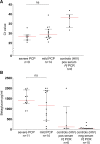Serum-based diagnosis of Pneumocystis pneumonia by detection of Pneumocystis jirovecii DNA and 1,3-β-D-glucan in HIV-infected patients: a retrospective case control study
- PMID: 31337356
- PMCID: PMC6651925
- DOI: 10.1186/s12879-019-4289-4
Serum-based diagnosis of Pneumocystis pneumonia by detection of Pneumocystis jirovecii DNA and 1,3-β-D-glucan in HIV-infected patients: a retrospective case control study
Abstract
Background: Pneumocystis jirovecii pneumonia (PCP) is one of the most common HIV-related opportunistic infections. The diagnosis of PCP is based on analyses from respiratory tract specimens which may require the invasive procedure of a diagnostic bronchoscopy. The objective of this study was to evaluate the diagnostic potential of Pneumocystis jirovecii PCR in serum combined with the 1,3-β-D-glucan (betaglucan) test for the diagnosis of PCP in HIV-infected patients.
Methods: This was a retrospective case-control study including serum samples from 26 HIV-infected patients with PCP collected within 5 days prior to the start of PCP treatment, 21 HIV-infected control subjects matched by blood CD4+ cell counts, and 18 blood donors. The serum samples were analyzed for Pneumocystis jirovecii PCR and betaglucan. The reference standard for PCP was based on previously described microbiological and clinical criteria.
Results: All patients with PCP had detectabe Pneumocystis jirovecii DNA in serum yielding a sensitivity for the Pneumocystis jirovecii PCR assay in serum of 100%. All blood donors had negative Pneumocystis PCR in serum. The specificity when testing HIV-infected patients was 71%, but with a PCR Cycle threshold (Ct) value of 34 as cut-off the specificity was 90%. At a putative pretest probaility of 20%, the negative and positive predictive value for the Pneumocystis PCR assay in serum was 0.99 and 0.71, respectively. Betaglucan with cut-off level 200 pg/ml combined with a positive Pneumocystis jirovecii PCR result had sensitivity and specificity of 92 and 90%, respectively. The concentration of Pneumocystis jirovecii DNA in serum samples, expressed by the PCR Ct values, correlated inversely to the betaglucan levels in serum.
Conclusion: In this case-control study including 70% of all HIV-infected patients with PCP treated at Sahlgrenska University Hospital during a time period of 13 years, Pneumocystis PCR analysis on serum samples had a very high sensitivity and negative predictive value for the diagnosis of PCP in HIV-infected patients. A serum-based diagnostic procedure either based on Pneumocystis jirovecii PCR alone or in combination with betaglucan analysis may thus be feasible and would facilitate the care of HIV-infected patients with suspected PCP.
Keywords: 1,3-beta-d-glucan; AIDS; Diagnosis; HIV; Pneumocystis jirovecii; Pneumocystis pneumonia; Polymerase chain reaction.
Conflict of interest statement
The authors declare that they have no competing interests.
Figures


Similar articles
-
Pneumocystis polymerase chain reaction and blood (1→3)-β-D-glucan assays to predict survival with suspected Pneumocystis jirovecii pneumonia.J Infect Chemother. 2014 Feb;20(2):109-14. doi: 10.1016/j.jiac.2013.09.004. Epub 2013 Dec 11. J Infect Chemother. 2014. PMID: 24480550
-
Diagnostic accuracy of (1→3)-β-D-glucan to predict Pneumocystis jirovecii pneumonia in non-HIV-infected patients.Radiol Oncol. 2020 May 28;54(2):221-226. doi: 10.2478/raon-2020-0028. Radiol Oncol. 2020. PMID: 32463392 Free PMC article.
-
Combined quantification of pulmonary Pneumocystis jirovecii DNA and serum (1->3)-β-D-glucan for differential diagnosis of pneumocystis pneumonia and Pneumocystis colonization.J Clin Microbiol. 2013 Oct;51(10):3380-8. doi: 10.1128/JCM.01554-13. Epub 2013 Jul 31. J Clin Microbiol. 2013. PMID: 23903553 Free PMC article.
-
Recent Advances in the Diagnosis of Pneumocystis Pneumonia.Med Mycol J. 2016;57(4):E111-E116. doi: 10.3314/mmj.16-00019. Med Mycol J. 2016. PMID: 27904052 Review.
-
Recent advances in the diagnosis of Pneumocystis jirovecii pneumonia in HIV-infected adults.Expert Opin Med Diagn. 2013 Jan;7(1):85-97. doi: 10.1517/17530059.2012.722080. Epub 2012 Oct 18. Expert Opin Med Diagn. 2013. PMID: 23530845 Review.
Cited by
-
An overview of the laboratory diagnosis of Pneumocystis jirovecii pneumonia.J Clin Microbiol. 2025 Mar 12;63(3):e0036124. doi: 10.1128/jcm.00361-24. Epub 2025 Feb 3. J Clin Microbiol. 2025. PMID: 39898657 Free PMC article. Review.
-
Relationship between clinical features and droplet digital PCR copy number in non-HIV patients with pneumocystis pneumonia.BMC Infect Dis. 2023 Nov 27;23(1):833. doi: 10.1186/s12879-023-08580-7. BMC Infect Dis. 2023. PMID: 38012564 Free PMC article.
-
Pneumocystis and Severe Acute Respiratory Syndrome Coronavirus 2 Coinfection: A Case Report and Review of an Emerging Diagnostic Dilemma.Open Forum Infect Dis. 2020 Dec 18;8(1):ofaa633. doi: 10.1093/ofid/ofaa633. eCollection 2021 Jan. Open Forum Infect Dis. 2020. PMID: 33537365 Free PMC article.
-
Global prevalence, mortality, and main characteristics of HIV-associated pneumocystosis: A systematic review and meta-analysis.PLoS One. 2024 Mar 25;19(3):e0297619. doi: 10.1371/journal.pone.0297619. eCollection 2024. PLoS One. 2024. PMID: 38526997 Free PMC article.
-
A Negative (1,3)-β-D-Glucan Result Alone Is Not Sufficient to Rule Out a Diagnosis of Pneumocystis Pneumonia in Patients With Hematological Malignancies.Front Microbiol. 2021 Aug 11;12:713265. doi: 10.3389/fmicb.2021.713265. eCollection 2021. Front Microbiol. 2021. PMID: 34456893 Free PMC article.
References
-
- Wilson JW, Limper AH, Grys TE, Karre T, Wengenack NL, Binnicker MJ. Pneumocystis jirovecii testing by real-time polymerase chain reaction and direct examination among immunocompetent and immunosuppressed patient groups and correlation to disease specificity. Diagn Microbiol Infect Dis. 2011;69(2):145–152. doi: 10.1016/j.diagmicrobio.2010.10.021. - DOI - PMC - PubMed
MeSH terms
Substances
Grants and funding
LinkOut - more resources
Full Text Sources
Medical
Research Materials

